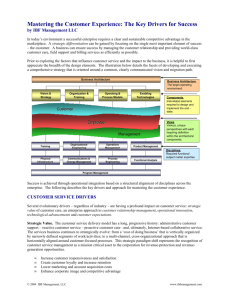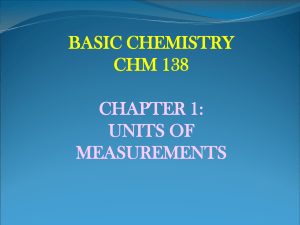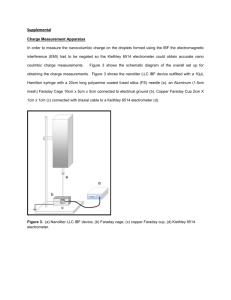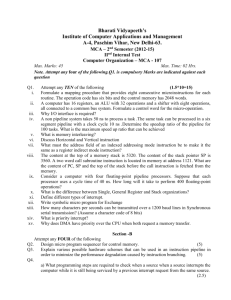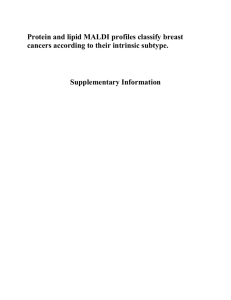MALDI-TOF-MS Sample Preparation for Synthetic Polymers via
advertisement
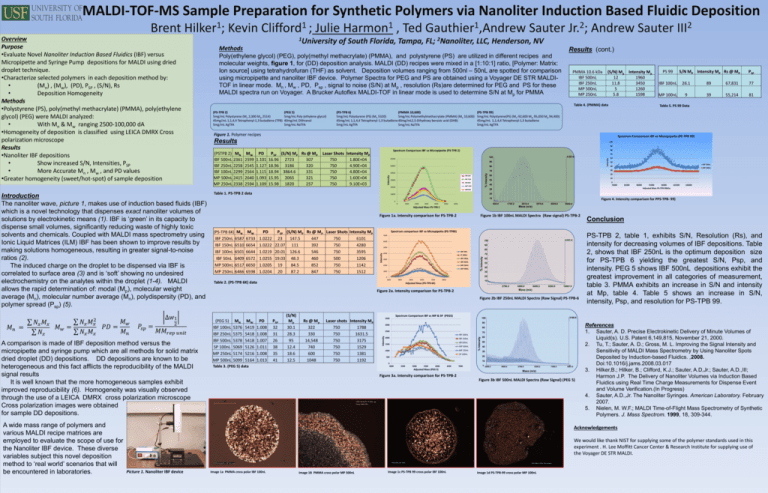
MALDI-TOF-MS Sample Preparation for Synthetic Polymers via Nanoliter Induction Based Fluidic Deposition Kevin Julie 1University Methods 1 Harmon 1 Gauthier ,Andrew , Ted of South Florida, Tampa, FL; 2Nanoliter, Poly(ethylene glycol) (PEG), poly(methyl methacrylate) (PMMA), and polystyrene (PS) are utilized in different recipes and molecular weights, figure 1, for (DD) deposition analysis. MALDI (DD) recipes were mixed in a [1:10:1] ratio, [Polymer: Matrix: Ion source] using tetrahydrofuran (THF) as solvent. Deposition volumes ranging from 500nl – 50nL are spotted for comparison using micropipette and nanoliter IBF device. Polymer Spectra for PEG and PS are obtained using a Voyager DE STR MALDITOF in linear mode. Mn , Mw , PD, Psp , signal to noise (S/N) at Mp , resolution (Rs)are determined for PEG and PS for these MALDI spectra run on Voyager. A Brucker Autoflex MALDI-TOF in linear mode is used to determine S/N at Mp for PMMA A wide mass range of polymers and various MALDI recipe matrices are employed to evaluate the scope of use for the Nanoliter IBF device. These diverse variables subject this novel deposition method to ‘real world’ scenarios that will be encountered in laboratories. PMMA 10.6 kDa IBF 500nL IBF 250nL MP 500nL MP 250nL (S/N) Mp Intensity Mp 12 1960 11.8 3450 5 1260 5.8 1598 Table 4. (PMMA) data (PS-TPB 2) 5mg/mL Polystyrene (Mn 2,300 Mw 2514) 45mg/mL 1,1,4,4 Tetraphenyl-1,3 butadiene (TPB) 5mg/mL AgTFA (PEG 5) 5mg/mL Poly (ethylene glycol) 40mg/mL Dithranol 5mg/mL NaTFA (PS-TPB 6) (PMMA 10,600) 5mg/mL Polystyrene (PS) (Mn 5320) 5mg/mL Polymethylmethacrylate (PMMA) (Mn 10,600) 45mg/mL 1,1,4,4 Tetraphenyl-1,3 butadiene 40mg/mL2,5-Dihydroxy benzoic acid (DHB) 5mg/mL AgTFA 5mg/mL NaTFA PS 99 S/N MP Intensity MP Rs @ MP PSP IBF 100nL 26.1 89 67,831 77 MP 100nL 9 39 55,214 81 Table 5. PS 99 Data (PS-TPB 99) 5mg/mL Polystyrene(PS) (Mn-92,600 Mw 95,050 Mp 94,400) 45mg/mL 1,1,4,4 Tetraphenyl-1,3 butadiene 5mg/mL AgTFA Figure 1. Polymer recipes Spectrum Comparison IBF vs Micropipette (PS-TPB 99) Results 100 90 MW 2599 2545 2564 2640 2594 PD 1.101 1.127 1.115 1.093 1.109 PSP (S/N) MP Rs @ MP 16.96 2723 307 18.96 3186 320 18.94 3864.6 331 15.95 2065 321 15.98 1820 257 Laser Shots Intensity MP 750 1.80E+04 750 4.90E+04 750 4.80E+04 750 1.60E+04 750 9.10E+03 70 4.8E+4 100 60000 Intensity (PSTPB 2) MN IBF 500nL 2361 IBF 250nL 2258 IBF 100nL 2299 MP 500nL 2415 MP 250nL 2338 80 Spectrum Comparison IBF vs Micropipette (PS-TPB 2) 90 50000 80 IBF100 IBF 250 30000 IBF500 MP 250 20000 Table 1. PS-TPB 2 data 0 76000 40 1000 2000 3000 4000 5000 1759.2 2819.4 3879.6 4939.8 Figure 1b IBF 100nL MALDI Spectra (Raw signal) PS-TPB-2 6101.0 100 6000 90 80 IBF 50nL 4000 70 IF 100nL IBF 150nL 3000 IBF 250nL 2000 MP 250nL MP 500nL 1000 % Intensity Intensity 5000 60 50 40 30 20 4800 5800 6800 7800 8800 10 Adjusted Mass (PS-TPB 6K) 2799.4 4599.8 6400.2 8200.6 10001.0 Mass (m/z) Figure 2a. Intensity comparison for PS-TPB-2 Figure 2b IBF 250nL MALDI Spectra (Raw Signal) PS-TPB-6 MN 5376 5375 5378 5069 5174 5099 MW 5419 5418 5418 5126 5216 5164 PD 1.008 1.008 1.007 1.011 1.008 1.013 PSP 32 31 26 38 35 41 Spectrum Comparison IBF vs MP & SP (PEG5) Rs @ Mp 322 330 14,548 740 600 1048 Laser shots Intensity MP 750 1788 750 1631.5 750 3175 750 1529 750 1381 750 1192 Table 3. (PEG 5) data 90 3000 80 2500 70 IBF 500nL 2000 IBF 250nL IBF100nL 1500 MP 500nL MP 250nL 1000 SP 100nL 500 60 50 40 30 20 10 0 4000 106000 4500 5000 5500 6000 6500 Adjusted Mass (PEG 5) 7000 0 2999.0 Conclusion PS-TPB 2, table 1, exhibits S/N, Resolution (Rs), and intensity for decreasing volumes of IBF depositions. Table 2, shows that IBF 250nL is the optimum deposition size for PS-TPB 6 yielding the greatest S/N, Psp, and intensity. PEG 5 shows IBF 500nL depositions exhibit the greatest improvement in all categories of measurement, table 3. PMMA exhibits an increase in S/N and intensity at Mp, table 4. Table 5 shows an increase in S/N, intensity, Psp, and resolution for PS-TPB 99. 3186.6 100 3500 % Intensity (PEG 5) IBF 100nL IBF 250nL IBF 500nL SP 100nL MP 250nL MP 500nL (S/N) Mp 30.1 28.3 95 12.4 18.6 12.5 101000 6000.0 7000 Table 2. (PS-TPB 6K) data 96000 Mass (m/z) Spectrum comparison IBF vs Micropipette (PS-TPB6) 0 3800 91000 Figure 4. Intensity comparison for PPS-TPB- 99) 699.0 6000 Figure 1a. Intensity comparison for PS-TPB-2 1.0222 1.0219 1.0255 1.0205 1.0204 86000 Adjusted Mass PS-TPB 99kDa Adjusted Mass PS-TPB 2 6654 6644 6572 6650 6598 81000 20 0 6510 6501 6409 6517 6466 MP 100nL 10 50 0 IBF 150nL IBF 100nL IBF 50nL MP 500nL MP 250nL IBF 100nL 40 20 60 10 PSP (S/N) MP Rs @ MP Laser Shots Intensity MP 23 147.5 447 750 6101 22.07 111 392 750 4280 20.01 126.6 546 750 3595 19.03 48.3 460 500 1206 19 84.5 852 750 1142 20 87.2 847 750 1512 50 30 10000 PD (PS-TPB 6K) MN MW IBF 250nL 6587 6733 1.0222 60 30 70 40000 Intensity A comparison is made of IBF deposition method versus the micropipette and syringe pump which are all methods for solid matrix dried droplet (DD) depositions. DD depositions are known to be heterogeneous and this fact afflicts the reproducibility of the MALDI signal results It is well known that the more homogeneous samples exhibit improved reproducibility (6). Homogeneity was visually observed through the use of a LEICA DMRX cross polarization microscope Cross polarization images were obtained for sample DD depositions. Andrew Sauter 2 III Results (cont.) MP500 Introduction The nanoliter wave, picture 1, makes use of induction based fluids (IBF) which is a novel technology that dispenses exact nanoliter volumes of solutions by electrokinetic means (1). IBF is ‘green’ in its capacity to dispense small volumes, significantly reducing waste of highly toxic solvents and chemicals. Coupled with MALDI mass spectrometry using Ionic Liquid Matrices (ILM) IBF has been shown to improve results by making solutions homogeneous, resulting in greater signal-to-noise ratios (2). The induced charge on the droplet to be dispensed via IBF is correlated to surface area (3) and is ‘soft’ showing no undesired electrochemistry on the analytes within the droplet (1-4). MALDI allows the rapid determination of: modal (Mp), molecular weight average (Mn), molecular number average (Mn), polydispersity (PD), and polymer spread (Psp) (5). Sauter 2 Jr. ; LLC, Henderson, NV % Intensity Overview Purpose •Evaluate Novel Nanoliter Induction Based Fluidics (IBF) versus Micropipette and Syringe Pump depositions for MALDI using dried droplet technique. •Characterize selected polymers in each deposition method by: • (Mn) , (Mw), (PD), PSP , (S/N), Rs • Deposition Homogeneity Methods •Polystyrene (PS), poly(methyl methacrylate) (PMMA), poly(ethylene glycol) (PEG) were MALDI analyzed: • With Mn & Mw ranging 2500-100,000 dA •Homogeneity of deposition is classified using LEICA DMRX Cross polarization microscope Results •Nanoliter IBF depositions • Show increased S/N, Intensities, PSP • More Accurate Mn , Mw , and PD values •Greater homogeneity (sweet/hot-spot) of sample deposition 1 Clifford ; Intensity Brent 1 Hilker ; 4099.4 5199.8 6300.2 7400.6 0 8501.0 Mass (m/z) Figure 3a. Intensity comparison for PS-TPB-2 Figure 3b IBF 500nL MALDI Spectra (Raw Signal) (PEG 5) References 1. Sauter, A. D. Precise Electrokinetic Delivery of Minute Volumes of Liquid(s). U.S. Patent 6,149,815, November 21, 2000. 2. Tu, T.; Sauter, A. D.; Gross, M. L. Improving the Signal Intensity and Sensitivity of MALDI Mass Spectrometry by Using Nanoliter Spots Deposited by Induction-based Fluidics. ,2008. Doi:10.1016/j.jams.2008.03.017 3. Hilker,B.; Hilker, B.; Clifford, K.J.; Sauter, A.D,Jr.; Sauter, A.D.,III; Harmon J.P. The Delivery of Nanoliter Volumes via Induction Based Fluidics using Real Time Charge Measurements for Dispense Event and Volume Verification.(In Progress) 4. Sauter, A.D.,Jr. The Nanoliter Syringes. American Laboratory. February 2007. 5. Nielen, M. W.F.; MALDI Time-of-Flight Mass Spectrometry of Synthetic Polymers. J. Mass Spectrom. 1999, 18, 309-344. Acknowledgements We would like thank NIST for supplying some of the polymer standards used in this experiment . H. Lee Moffitt Cancer Center & Research Institute for supplying use of the Voyager DE STR MALDI. Picture 1. Nanoliter IBF device Image 1a PMMA cross polar IBF 100nL Image 1B PMMA cross polar MP 500nL Image 1c PS-TPB 99 cross polar IBF 100nL Image 1d PS-TPB-99 cross polar MP 100nL
